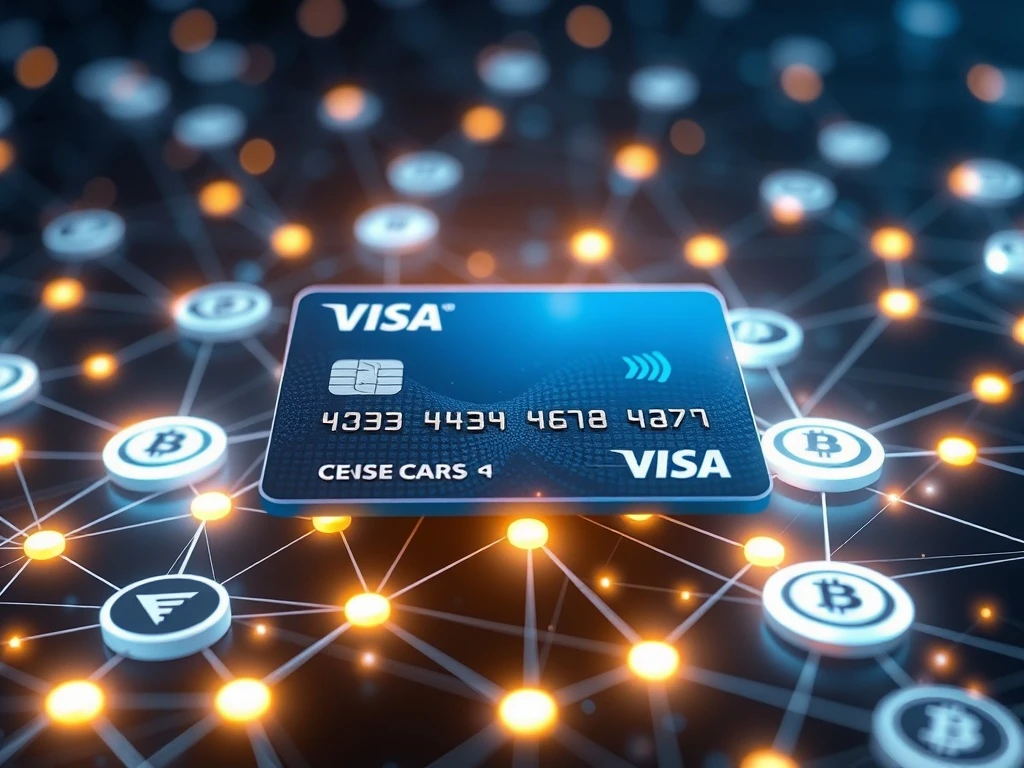Visa’s **Revolutionary** Stablecoin Support Transforms Global Payments

The financial landscape is rapidly evolving, and global payments giant Visa is at the forefront of this transformation. In a significant move, Visa is expanding its stablecoin support across four new blockchains, marking a pivotal moment for digital currency integration into mainstream finance. This strategic expansion signals a deeper commitment to crypto services, promising enhanced efficiency and accessibility for users worldwide.
Visa’s Expanding Horizon: Bolstering Stablecoin Support
Global payments giant Visa is rolling out support for four additional stablecoins across four distinct blockchains. This initiative underscores the firm’s drive to enhance its crypto services. Visa CEO Ryan McInerney shared these developments during the company’s fourth-quarter and year-end earnings call. He emphasized the continued expansion of stablecoin offerings, citing robust growth over the past financial year.
Specifically, McInerney stated, “We are adding support for four stablecoins running on four unique blockchains. These represent two currencies we can accept and convert to over 25 traditional fiat currencies.” While he did not disclose the exact stablecoins or networks, this expansion significantly bolsters Visa’s existing digital asset capabilities. Currently, Visa already backs stablecoins such as Circle’s USDC (USDC) and Euro Coin (EURC). They also support PayPal USD (PYUSD) and Global Dollar (USDG). These operate on established blockchains like Ethereum, Solana, Stellar, and Avalanche. This broadens their reach, ultimately benefiting a wider range of financial institutions and consumers.
Driving Momentum in Blockchain Payments and Crypto Services
Visa observes substantial momentum with stablecoins. McInerney highlighted that the company has facilitated an impressive $140 billion worth of crypto and stablecoin flows since 2020. This figure demonstrates the increasing adoption and utility of digital currencies within their ecosystem. Furthermore, global consumer spending within Visa’s stablecoin-linked card services surged fourfold in its fourth quarter, compared to the same period last year. This growth indicates strong user confidence and demand for these innovative financial tools.
“We expanded the number of stablecoins and blockchains available for settlement,” McInerney added. “Monthly volume has now passed a $2.5 billion annualized run rate.” This metric showcases the operational scale and success of Visa’s integration efforts. The firm’s commitment to stablecoins positions it as a key player in the evolving digital finance landscape. They are actively bridging traditional financial systems with the burgeoning crypto economy.
Empowering Banks: Visa Doubles Down on Stablecoin Banking
A primary focus for Visa involves broadening its stablecoin offerings for banks and other traditional financial institutions. The company also aims to facilitate more efficient cross-border transactions. McInerney affirmed, “there is much more to come in this space.” This suggests a long-term vision for stablecoins within Visa’s strategic framework. The journey began in late September with a Visa Direct pilot program. This program allowed banks and financial institutions to pre-fund cross-border payments using USDC and EURC. This initiative streamlined the process for international money transfers.
The next stage, according to McInerney, will involve enhancing and investing in Visa’s solutions layer. This will enable the firm to offer more advanced features to its clients and partners. A concrete example includes the crucial functionality of minting and burning stablecoins. This capability provides banks with greater control and flexibility over their digital asset operations. It represents a significant step towards full institutional adoption of stablecoins.
The Future of Finance: Minting and Burning for Cross-Border Transactions
Visa is now enabling banks to mint and burn their own stablecoins. This groundbreaking feature leverages the Visa tokenized asset platform. It empowers financial institutions with direct control over digital asset creation and destruction. This innovation simplifies the management of digital reserves. Furthermore, Visa is adding stablecoin capabilities to enhance cross-border transactions through Visa Direct. This service already facilitates rapid and secure international payments. Integrating stablecoins will make these transactions even faster and more cost-effective.
This development is particularly relevant as stablecoins gain recognition as a “global macroeconomic force.” Reports indicate that stablecoin transactions have reached an astonishing $46 trillion. Visa’s proactive stance ensures it remains at the forefront of this financial revolution. The company is not merely observing trends; it is actively shaping them. By offering advanced stablecoin infrastructure, Visa is paving the way for a more interconnected and efficient global financial system. This commitment solidifies its position as a leader in digital payments innovation.
Impact on the Ecosystem: Broader Adoption of Blockchain Payments
Visa’s expanded blockchain payments strategy holds significant implications for the broader cryptocurrency ecosystem. By integrating more stablecoins and blockchains, Visa lowers barriers to entry for traditional financial institutions. This fosters increased institutional adoption of digital assets. Banks can now leverage Visa’s robust infrastructure to offer stablecoin-related services to their customers. This includes faster international settlements and improved liquidity management. Consequently, this move could accelerate the mainstream acceptance of cryptocurrencies.
Moreover, the ability for banks to mint and burn stablecoins on the Visa platform represents a new paradigm. It allows financial institutions to manage their digital asset portfolios with greater autonomy and efficiency. This development also promotes interoperability between various blockchain networks and traditional payment rails. As Visa continues to innovate in this space, we can expect further advancements that streamline financial operations globally. The payments giant is clearly committed to integrating digital currencies into the fabric of everyday commerce, making crypto services more accessible than ever before.







